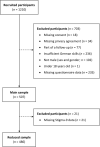Precarious Manhood Beliefs Are Positively Associated with Erectile Dysfunction in Cisgender Men
- PMID: 37351710
- PMCID: PMC10684399
- DOI: 10.1007/s10508-023-02640-4
Precarious Manhood Beliefs Are Positively Associated with Erectile Dysfunction in Cisgender Men
Abstract
The notions that manhood is hard to attain, easy to lose, and needs to be proven via public action constitute precarious manhood beliefs (PMB). PMB is a new concept and it remains unclear whether and how PMB relate to erectile dysfunction (ED) in cisgender men. The ability to achieve an erection remains considered as a cornerstone of masculinity and sexual performance can be conceived as a proof of one's masculinity. In this context, ED can be received as sexual failure and a threat to a man's masculinity and sense of adequacy. For these reasons, the hypothesis that PMB are associated with ED warranted empirical testing. In an anonymous online survey focusing on men's mental health conducted in German-speaking countries of Europe, 507 cisgender men (Mage = 44.2, SDage = 15.2) completed measures on PMB, sexual function, self-stigma, social desirability, and conformity to traditional masculinity ideology (TMI). Multilinear regression analysis with stepwise introduction of relevant covariates evaluated potential associations between PMB and ED. Of a 507 cisgendered male sample, 63.1% reported an increased risk for ED based on previously established cutoff points. Elevated levels of PMB endorsement among the men predicted reduced sexual and erectile function in all models, even when accounting for relevant control variables such as age, education, self-stigma, social desirability, or conformity to TMI. Group comparisons revealed that the men suffering from ED showed higher levels of PMB endorsement but not self-stigma nor TMI relative to men without ED. PMB are significantly associated with ED. While determining causality will require further study, our results may support the hypothesis that higher levels of PMB endorsement may lead to increased tension to perform sexually, resulting in increased psychological pressure and a higher risk to develop ED.
Keywords: Erectile dysfunction; Masculinity; Precarious Manhood Beliefs; Sexual dysfunction; Sexual function.
© 2023. The Author(s).
Conflict of interest statement
The authors declare no conflict of interest.
References
-
- Andersson E, Walén C, Hallberg J, Paxling B, Dahlin M, Almlöv J, Källström R, Wijma K, Carlbring P, Andersson G. A randomized controlled trial of guided internet-delivered cognitive behavioral therapy for erectile dysfunction. Journal of Sexual Medicine. 2011;8(10):2800–2809. doi: 10.1111/j.1743-6109.2011.02391.x. - DOI - PubMed
-
- Baglia J. The Viagra ad venture: Masculinity, marketing, and the performance of sexual health. Peter Lang Publishing; 2005.
-
- Bergvall L, Himelein MJ. Attitudes toward seeking help for sexual dysfunctions among US and Swedish college students. Sexual and Relationship Therapy. 2014;29(2):215–228. doi: 10.1080/14681994.2013.860222. - DOI
Publication types
MeSH terms
Grants and funding
LinkOut - more resources
Full Text Sources
Medical


